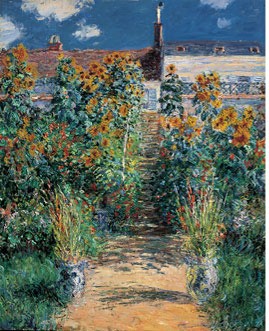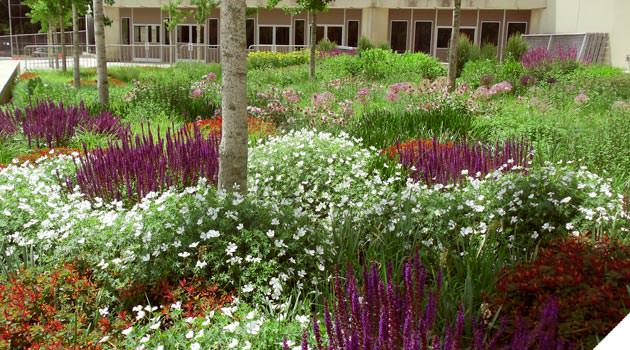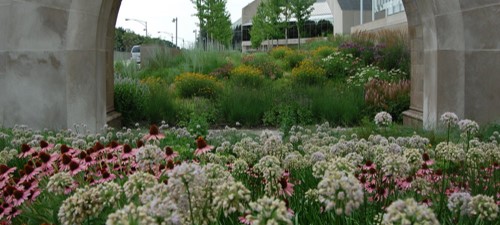In the garden, January is a quiet month. Most of its pleasure comes from thinking about gardening, not from gardening itself. This may the case every month, come to think of it.
But things are happening: the world is gathering force for great change. Hard little buds have formed on the trees, and the foliage for some early bulbs is already pushing up through the mud. It’s a time for transforming hazy ideas into concrete plans, with budgets.
In the Facebook Kansas City Gardening Group, I see frequent posts asking when to start seeds. I’m not planning to grow plants from seeds myself, although I have brought home a few interesting-looking seedheads from plants I’ve passed in the woods. I’m not sure what they are. I’ll keep you posted. Last year I succumbed to temptation and sowed some yarrow seeds in a Styrofoam egg carton. I set them in a sunny window near my desk and misted them each day. Sure enough, they sprouted. They were very slow-growing. I put them outside on a warm day and they drowned. Raindrops pelted them flat. They looked like a bunch of wet threads. They were too far gone to revive, so into the trash they went.
I understand they would have taken a few years to bloom.
Of course, not all seeds require so much patience. Usually, I direct sow some alyssum and zinnias, and I probably will again this year, but I’m not going to get too worked up about seeds. They appeal to me in part as a way to save money. Every gardener I talked to last year commented about how expensive gardening can be. Last year, my strategy for saving money was to stick to a plan.
Last week I mentioned Roby Diblik’s The Know Maintenance Perennial Garden, which contains several plans for home gardeners like me to use as jumping off points. (That’s his garden at the Art Institute of Chicago at the top of the post.) Each features a community of plants intended to be pretty much self-sustaining. They’re inspired by impressionist paintings or famous gardens like the High Line. The plan I’m using takes its inspiration from Monet’s The Artist’s Garden at Vétheuil.

My budget was $100. I ordered plants online from Prairie Nursery in Wisconsin. They sell a 32-plant kit that can contain up to six species for $119.
Diblik’s plan is for a 10’ x 14’ bed and calls for 57 plants from six species, not including bulbs. My plot is 5’ x 16’ and has a bunch of stuff already growing in it, including a grapevine and one productive blueberry bush. To help me visualize, I drew my plan on a piece of brown craft paper. I folded the paper into twelve-inch squares to make a grid. Then I colored big circles where the plants would go. It looked like Twister. I spread this paper over the ground for a couple weeks while I was waiting for my plants to arrive, hoping to help suppress weeds: soil solarization lite. Did it work? I don’t know. The ground is pretty inhospitable. Not many weeds have sprouted, but I don’t know what it would have been like if I hadn’t used the paper.
I placed my order on March 1. The plants arrived a few weeks later. They were plugs. I’d planned to cut holes in my paper and plant through them, leaving the paper on the ground, but I think I gave up on that. The results aren’t exactly what I hoped—I doubt anyone would recognize Monet’s The Artist’s Garden at Vétheuil as the inspiration, and who knew how much rabbits love eating asters? I blame all shortcomings on the modifications I made to Diblik’s plan, and my lack of knowledge about the plants and site. Live and learn. We’ll see how they do this spring.
I’m planning to do pretty much the same thing again this year, although I’m shifting my attention onto other areas of the yard. I’ve learned a lot about plants, and I’m going to buy some favorites—so I’ll muck up Diblik’s plan even more. Last week I attended an online class, “Starting a Native Plant Garden,” given by the Dyck Arboretum of the Plains in Hesston, Kansas. They offer a series of education programs called Native Plant School that are a perfect fit for my interests. The presentation covered big picture topics, like where native plants are appropriate (everywhere), how they are beneficial, site considerations, and planning for succession of bloom. The presenter, Scott Vogt, used images of the High Line and Piet Oudolf’s garden at Hummelo, as well as a drawing from Planting in a Post-Wild World to illustrate the concept of planting in layers.
During the second half-hour, Vogt showed slides of recommended plants for our area. You can watch the video of the presentation here:
When these plants appeared on my screen, my pulse quickened and I felt alert. I had a visceral response to all that color, just like I do to plants in real life.
I remember my mother telling me that on a visit to England she watched a television show that was just flower pictures. The announcer would say, “Oh, here’s a lovely one.” We thought that was hilarious, but now I’d like to watch that show on TV.
The next session in the Native Plant School is “Mighty Oaks: Kansas Natives for Your Landscape” on Wednesday, January 20. Presenter Brad Guhr wrote a terrific blog post about an ancient oak tree in December, “A Grand Old Burr Oak.”
Future classes include one about attracting Monarchs on February 3, and “The Native Cutting Garden” on February 24. The classes cost $5.
My own beds are a work-in-progress, but for inspiration, here’s an image of a mature garden that uses some of the same plants.


Thank you for sharing your past experience and upcoming plans for this year! I am learning too and am trying to set reasonable expectations for my plans, which is hard to do for me. I too attended Scott Vogt’s virtual presentation on native plants through the Dyke Arboretum the other week – it was incredibly informative and inspired me to learn more about matrix planting. Please keep sharing your wonderful writing with us. Thank you!
Jennifer, thank you so much! My introduction to matrix planting is Planting: A New Perspective, by Noel Kingsbury and Piet Oudolf, but I haven’t really been able to apply the idea. The sheer number of plants is overwhelming. Do you have a large site? Are you going to attend any of the other classes? I’ve got my eye on the Native Cutting Garden on February 24. Thanks for reading.